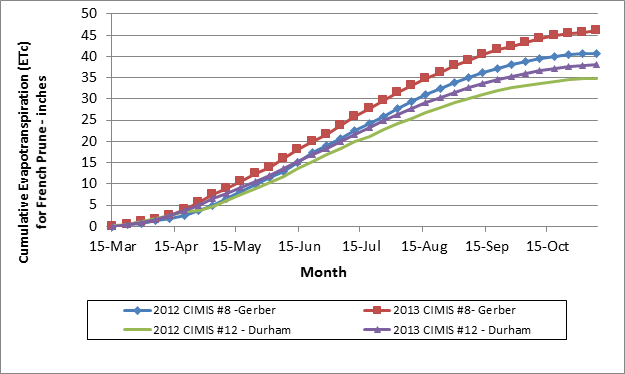Adapted from the article “Irrigating French prune during a drought” by Richard P. Buchner – UC Cooperative Extension Farm Advisor, Tehama County and Allan E. Fulton –UC Cooperative Extension Farm Advisor, Tehama, Glenn, Colusa and Shasta Counties in the April 2014 Sacramento Valley Prune News.
The first way to manage a limited water supply is to operate an irrigation system as efficiently as possible. A system that applies water uniformly across an orchard will enable water to be applied more efficiently. The Tehama County Mobile Irrigation Lab provides free irrigation system performance evaluations to growers in Tehama, Glenn, Butte and Shasta Counties. Call Kevin Greer at (530) 527-3013, ext. 102 to arrange an evaluation. Growers in Sutter, Yuba, and Colusa Counties may also ask about their availability.
The starting point for managing a high performing irrigation system is to understand the seasonal cumulative water use for prune trees where water supply is not limiting evapotranspiration (ET). Figure 1 shows the water use patterns for prunes grown in different areas of the Sacramento Valley during 2012 and 2013. Real-time information for the current season is available on-line.

Figure 1. Cumulative water use by French prune orchard in Sacramento Valley.
These data show cumulative water use from bloom (March 15) to the end of the season (November 10) can vary between seasons and farming areas. Cumulative ET ranged between 35 and 45 inches in 2012 and 2013. Average annual ET is about 40 inches for prune. Assuming a 6 inch contribution from soil water storage in the root zone and 1 or 2 inches of effective rainfall in the spring, the net irrigation requirement for these examples would range from about 27 to 37 inches plus any additional application to account for irrigation distribution uniformity.
Deficit or Regulated Deficit Irrigation (RDI) is the next consideration for managing limited water. RDI is a strategy of withholding irrigation water to levels less than full ET. Water is withheld at specific times and in specific amounts during the season that will limit detrimental effects on the tree, developing crop, and future production. It may be possible to realize benefit from RDI particularly during a drought. The challenge to managing crop water stress is evaluating when and how severe water stress really is. Fortunately, pressure chambers and measurements of Stem Water Potential (SWP) are gaining in use and interpretive guides are available to predict the impact of crop water stress on tree performance. In addition, several prune irrigation experiments have been published looking at the effects of water stress severity and duration.
UC research found withholding water and creating even mild water stress at all pre-harvest stages of tree and fruit development between May and September decreased fruit diameter at harvest. Mild early spring water stress decreased final fruit diameter by 10%. Final fruit size was reduced the greatest, 25-35% when water was withheld from May through mid-July. The negative effect on fruit size increased as the duration of withholding water was lengthened. Other UC research found that vegetative growth is reduced and fruit load can be lowered when very early season crop stress is imposed for consecutive years. Fruit size and weight were mildly reduced by early season cutoff. Dry ratios tended to be lower and soluble solids higher with longer irrigation cutoff.
More recent work at UC Davis evaluated the sensitivity of seasonal growth stages of French prune to water deprivation by measuring SWP with a pressure chamber. They concluded that for mid- and late season water stress up to about -20 bars SWP, there was no fruit growth stage of French prune that was particularly sensitive to water stress. Severe and prolonged crop prolonged stress of -20 to – 30 bars did lead to smaller fruit with lower quality and trees with less vigor.
In summary
- Early season water stress may reduce vegetative growth resulting in crop reduction due to less fruiting positions, especially if the early season water deprivation occurs over consecutive years.
- Early season crop water stress followed by more intensive irrigation to correct the water deprivation appears to increase end cracks. Avoid early season crop stress to prevent cracking.
- Mild to moderate irrigation deficit after mid-June does not appear to affect fruit drop.
- Moderate to severe irrigation deficit during green fruit sizing can reduce dry fruit size.
- French prune appears to tolerate mid to late season water stress fairly well.
- Late season irrigation deficit from reduced irrigation or earlier irrigation cutoff appears to improve dry ratio and soluble solids.
- If faced with a reduced water supply and unable to supply full ET, cutting back on water mid to late season and avoiding substantial crop stress early to mid season may be a reasonable strategy.
- The pressure chamber and use of SWP measurements is a useful management tool to help employ a successful drought management strategy.
Adapted from the article “Irrigating French prune during a drought” by Richard P. Buchner – UC Cooperative Extension Farm Advisor, Tehama County and Allan E. Fulton –UC Cooperative Extension Farm Advisor, Tehama, Glenn, Colusa and Shasta Counties in the April 2014 Sacramento Valley Prune News


Leave a Reply